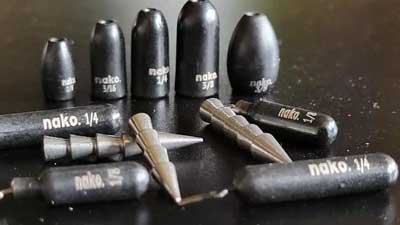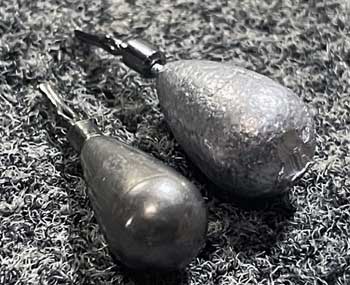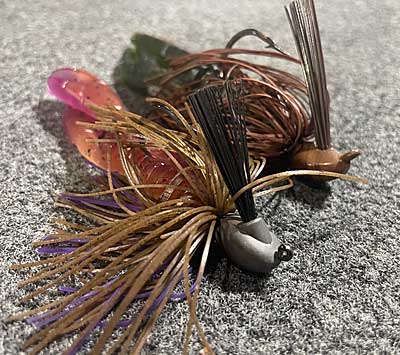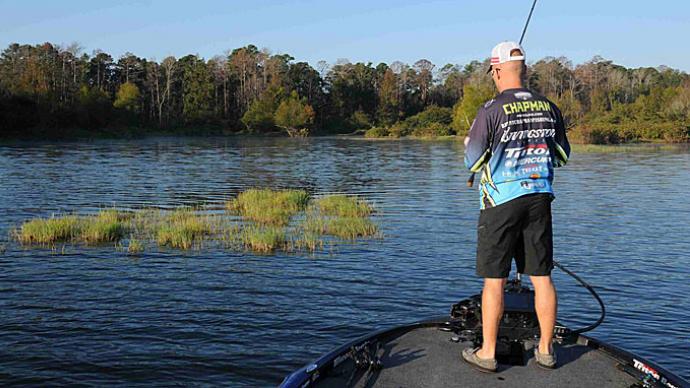
Over the past decade, tungsten fishing weights and lures have become more popular. They are more expensive than lead, although companies make them more affordable. Still, they cost more than lead, making some anglers question if they are worth it. Many anglers will emphatically say that they are, as they provide many benefits that help outweigh the higher costs.
Tungsten weights are more sensitive, smaller, and better for the environment. Those are the three biggest reasons many anglers switch from lead to tungsten weights.
Size Reduction
Looking at two identical weight sizes, one made of lead and one with tungsten, you will see a stark difference in the physical size of the two. Tungsten weights are nearly half the size of their lead counterparts, offering many advantages for anglers.

The smaller size allows for a more compact presentation with Texas-rigged soft plastics. A smaller weight fits snugly with a soft plastic bait and helps to make it look more natural as it is more concealed next to the bait. The array of colors available for tungsten weights also perfectly matches popular soft plastic colors. The durable finish used on quality tungsten worm weights helps prevent paint chipping after coming into contact with rocks, wood, and other objects.
The smaller size allows anglers to use heavy tungsten weights that weigh over an ounce for techniques like punching, where crashing through matted vegetation enables anglers to reach bass that would otherwise be completely inaccessible. The punching technique hit the mainstream around the same time as tungsten weights became popular because tungsten made it possible.
Even though the weights used for punching are big, they are still manageable and allow anglers to fish this way effectively. Previously, no lead alternatives were available on the market. They weren't heavy enough to penetrate heavy vegetation. A lead weight over one ounce would also add substantial bulk to the rig, likely leading to fewer bites from bass.
The popular Neko Rig technique uses nail weights inserted into soft plastic. Lead weights may work fine for some sizes, but tungsten has a decided advantage as the weight size increases. When inserted into a soft plastic, a bulky lead weight distorts the shape of a soft stick bait or finesse worm, and tungsten is a much better choice for a natural presentation.
Increased Sensitivity
As a result of being smaller and more compact, tungsten weights are much more dense than lead. They are 1.7 times denser than lead, leading to a more sensitive feel for anglers. This matters for bass fishing since tungsten weights offer a much better bottom feel. This is arguably the most significant benefit of tungsten weights, as anglers can quickly feel bites and contact with the bottom.

For bottom contact techniques like Texas-rigs, Carolina-rigs, and drop-shot rigs, tungsten offers a massive advantage in feeling the bottom. It quickly detects rocks and changes in bottom composition from sand to gravel or rock to mud. These subtle differences in the bottom are often crucial as fish gravitate to them, and feeling the change can give you a clue to slow down or shake your bait in place longer to generate bites from fish in the area.
Tungsten weights are a standard in the bullet weight style and drop-shot weights, but there are also specialty Carolina-Rig weights with a compact barrel-shaped weight that are great for the technique.
A side benefit to using tungsten weights, especially drop-shot weights, is that the added density allows them to show up much better in the water when viewing your marine electronics. This is imperative for those with forward-facing sonar, as tungsten weights show up much easier and clearer as they fall to the bottom compared to using a lead weight.
Environmental Reasons
Several states have enacted laws and regulations preventing lead fishing tackle and lead shotgun shells. The reason is to help protect our waterways from the dangers of lead and protect birds like loons that eat small rocks and mistakenly eat harmful lead sinkers.

If doing your part to protect the environment is essential to you, using tungsten may be your best option. It may also be your only option, as there are restrictions and outright bans of lead lures in some states. It is almost certain that more states will adopt similar regulations as lead continues to be pushed away for environmental reasons in the coming years.
Tungsten Jigs and Jigheads
Tungsten weights get the most use from bass anglers, but you can experience the same advantages of tungsten over lead to jigs and other jigheads. Tungsten jigs offer a better bottom feel and are much more compact. Other items using tungsten that may be worth consideration are shaky heads, underspins, and various other jigheads.
The Disadvantages: Cost
Nobody likes to lose fishing tackle, but it happens. Losing weights and baits is part of the game in areas full of snags. This hurts more with tungsten's cost, the most significant and likely only disadvantage to using tungsten instead of lead fishing weights.
The cost of tungsten is still high, but there are more reasonable options now that more companies have entered the market. They still cost more than lead weights, but competition from various brands has become a little closer in recent years. This will likely continue as tungsten continues to be a popular option for bass anglers.
There are many advantages to using tungsten weights over lead. They offer much more sensitivity, are smaller and more compact, and are better for the aquatic environment. As anglers continue to learn about the advantages of tungsten, more and more anglers will make the switch.




